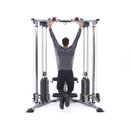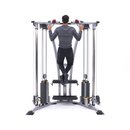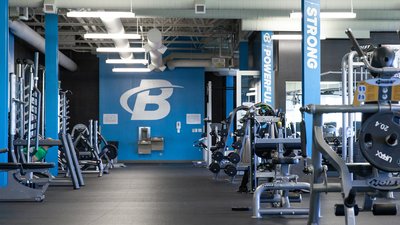No matter your goals in the gym, back training may be one of the best uses of your time. Whether it's hoisting big weights overhead in the O-lifts, pulling heavy deadlifts, or simply looking ripped in a tank top, a big, thick back will help you get there.
However, building a jacked upper back is a long-term endeavor. It takes dedication, discipline, and focus over years to develop the kind of back that other people envy. It's virtually unachievable for those with training ADD. But if you're willing to check your ego at the door and work both hard and smart, then your prizes will be greater strength, balance, and health. Not many muscle groups can promise that!
Let's begin our bigger back journey by examining the anatomy of your back, so that we can better understand how to train it.
That's the Joint
Three primary joints influence training of the upper back: the thoracic spine, scapulae, and gleno-humeral joint.
The thoracic spine consists of the 12 vertebrae, arrayed with your rib cage. While many are quick to gloss over the thoracic spine—maybe because lower-back pain is so common—its importance can't be overstated. There should be a natural kyphosis, or forward bend, to the thoracic spine. When it gets out of whack, you can have trouble turning your neck, develop horrible posture, and have trouble lifting a pencil, let alone a barbell.
Next we have the scapulae, or shoulder blades. The scapulae are interesting bones because unlike other joints (i.e. the knees, hips, and shoulders) there is no bony connection between the scapulae and the thoracic spine, which it rests on. Instead, the ability to control and/or position the scapulae appropriately is entirely reliant on the muscles attached to the scapulae.
Last but not least, the gleno-humeral joint is the ball-and-socket that most of us imagine when we hear the term "shoulder." This is where the head of your humerus intersects with the glenoid fossa of the scapulae, and as with any ball-and-socket joint, it has wide ranges of motion.
Back Anatomy—And What it Means to You
Now that we've briefly discussed the joints involved, let's look at the individual muscles we'll be training. It's worth noting that while the back comprises several large and several small muscles, the small ones can cause plenty of discomfort—especially if you sit at a desk all day.
The lats are one of the largest muscle groups in the body. Every bodybuilder worthy of the name has spent some serious time in the trenches working on his or her lats, and for good reason. Not only are they a prize showpiece on stage, they also factor centrally into plenty of other muscles and movements.
The lats are not only responsible for extension, adduction, and internal rotation at the humerus (the upper arm), but they also increase extension in the lumbar spine. The proximal attachment of the lats has numerous connections, including the thoraco-lumbar fascia of the lower back, the iliac crest, and the inferior border of the scapulae. The distal attachment point is on the anterior portion of the humerus, up near the back of the armpit.
The rhomboids are much smaller than the lats, but they provide a crucial structural link between the scapula and vertebrae. They also affix the scapula to the back of the thoracic cavity. There are two sections of the rhomboids, conveniently named the rhomboid major and minor, which run parallel in a diagonal line from a proximal attachment point on the thoracic spine (specifically spinous processes of C7-T5), to a distal attachment point on the medial (interior) border of the scapulae.
In terms of movements, they are responsible for retracting your scapulae, like you would in a rowing exercise. The rhomboid major also downwardly rotates your scapulae.
The trapezius muscles are the two big half-diamond shaped muscles that lay over your rhomboids. Like the rhomboids, the traps have different subsections: the upper (or superior), middle, and lower (or inferior) fibers of the trapezius.
Covering all the various attachment points can become cumbersome, so if nothing else, remember this: The traps are a big muscle! The proximal attachments of the trapezius run from the base of your skull all the way down to T12, just above your lumbar. Along the way, the traps link to the various bony prominences on your acromion, clavicle, and scapulae.
In isolation, the upper traps elevate the shoulder, the middle traps retract the scapulae, and the lower traps depress the scapulae. In concert, the traps work to retract the shoulder. The upper and lower trapezius also work together, along with the serratus anterior, to upwardly rotate the scapulae. This movement is important if you want to lift your arm overhead.
The levator scapulae is a small muscle just above your rhomboid that can cause big problems. The levator scap originates on the transverse processes of C1-C4—all the way at the top of your neck—and attaches on the medial border of the scapula. It's not only an elevator of the scapulae, but a downward rotator as well.
Many of you may already be familiar with this muscle, even if not by its name. The head-forward posture of seated computer work can make both the levator scapulae and the upper trapezius get short and stiff, leading to what many refer to as a "stiff neck." It can also contribute significantly to headaches.
Last but not least, I could discuss the rotator cuff here as well, since it plays a central role in movements of the scapula, humerus, and shoulder joint. However, I already covered the cuff in The Science of Shoulder Training. Rather than rehash it here, take a few moments to review that article.
Training the Back
Now that you know the foundation, let's talk about training. The easiest way to think about training the upper back is to break it down into three basic movement patterns, all centered around pulling.
- Horizontal Pulling (rowing variations)
- Vertical Pulling (chin-up and pull-up variations)
- Face Pulls
Horizontal pulling motions activate the rhomboids and the trapezius muscles. The goal of any horizontal pulling exercise is to retract the shoulder blades, squeezing them together.
The goal of vertical pulling is two-fold. Whether you're pulling yourself up or pulling weight down, both train the lats, which extend the shoulders. This movement also works the lower trapezius, which enables scapular depression.
Last but not least we have the face pull, which is a hybrid of vertical and horizontal pulls. When performing a face pull, the goal is to get a blend of scapular retraction and depression. While you can't load up the face pull as much as you can for a big rowing or chinning movement, it is fantastic for both developing the mind-muscle connection with the muscles of the mid-back, and training the external rotators of the shoulder.
It all sounds simple enough, right? Except that back exercises might the easiest movements to cheat on. Maybe it's that we associate the back with strength so much; whatever the reason, look around at the gym, and you'll see almost everybody loading weights up, using a ton of body English, and writhing like caged animals when they sit down to row.
Back In Business
Now that we covered what we try to achieve with each movement, I'll offer three crucial tips to help you maximize—or rescue—your back training.
1. Rock Solid Spine On Rows
Watch most people row, and you'll quickly realize why they don't have a big, strong upper back.
Instead of moving the shoulder blades—the appropriate muscles for the work—they hinge their upper and lower back all over the place in an effort to move huge piles of weight. It may sound elementary, but this deserves emphasis: Your goal should be to move the actual joints (and use the actual muscles) you're trying to train.
When rowing, focus on locking down your upper and lower back. Set them in place, and then think about allowing your shoulder blades to glide to the front on the eccentric or lowering phase, and then retract them on the concentric phase.
If that feels difficult, it's probably because you're using too much weight. There's a tip I love from the legendary row-master Dorian Yates that goes something like this: If you can't hold a row for at least one second at the midpoint, you're using too much momentum. Drop the weight and do it right.
Leave the super heavy weights and contortions to the experienced trainees out there. Chances are by dropping the weight and targeting the correct muscles, you'll get more development than you ever achieved in the past.
2. Full Protraction On Rows
If you're rowing, I don't care how much range of motion your shoulder and elbow go through. All I'm looking for is full protraction and retraction at the scapulae.
This may sound strange, but many people are what I would consider rhomboid "dominant," meaning their rhomboids are stronger and stiffer than the antagonistic muscle, in this case the serratus anterior. As a result, they really don't like to protract their scapulae.
Rows should be focused on the scapulae and the muscles surrounding them. To get more bang for your training buck, you should stabilize the thoracic spine and allow the weight to pull and lengthen the muscles between your shoulder blades—i.e., the rhomboids. This will lead to better muscle balance around the scapulae, as well as a better contraction on the ensuing repetitions.
3. Full Range of Motion On Pull-Ups
This might be the most challenging tip I could give you, but it will probably have the biggest impact.
I don't like the term "chin-up." My advice is to think only in terms of pull-ups instead. Actually, the goal should be to do a chest-up, where your pull your chest to the bar. It's not uncommon for clients I work with initially to be able to do 15-20 body weight chins, yet can't do a single repetition where their chest actually touches the bar.
Just as importantly, concentrate on actively squeezing your shoulder blades down while you're in that top position. Pavel Tsatsouline refers to this as "pulling your shoulder blades into your back pocket."
Don't let all that work at the top make you neglect the base of your pull-up. Make sure to let those elbows and shoulders unwind at the bottom. This will put more stretch on the lats and create a stronger contraction.
The Ultimate Balanced Back Workout
Ever seen an "ultimate workout" made up of just three movements? Well, the focus here is on quality work, not quantity. Do the repetitions through a full range of motion, and focus on control and maximal contractions at the midpoint.
If you do these correctly, you're going to find soreness in new areas after your next workout. I promise!



BodyFit
$6.99/month- 2,500+ expert-created single workouts
- 3,500+ how-to exercise videos
- Detailed workout instruction
- Step-by-step workout tips
- Training at gym or at home
- Access to Workout Plans
- Access to Bodyfit App
- Store Discounts
Already have a Bodybuilding.com account with BodyFit? Sign In

What comes with BodyFit?

- Instructional Videos
Don't risk doing a workout improperly! Avoid injury and keep your form in check with in-depth instructional videos.

- How-to Images
View our enormous library of workout photos and see exactly how each exercise should be done before you give it a shot.

- Step-by-Step Instructions
Quickly read through our step-by-step directions to ensure you're doing each workout correctly the first time, every time.


